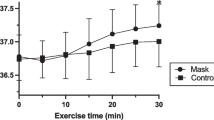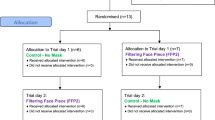Abstract
Aim
The study aimed at discovering the effects of wearing two types of protective mask on the clothing microclimate (temperature, humidity) inside the mask, physiological parameters and subjective sensations.
Method
Five healthy female students performed intermittent step exercise while wearing the protective clothing in a climate chamber at 28°C and 60% relative humidity (RH). One mask was made of non-woven fabric and had no exhaust valve (mask A), and the other had an exhaust valve (mask B).
Results
(1) Clothing microclimate temperature inside the mask was significantly lower in mask B than in mask A. The final values were 35.5±0.3°C in mask A and 34.6±0.8°C in mask B. (2) Clothing microclimate humidity inside the mask was significantly lower in mask B than in mask A. The final values were 37.9±0.9 g/m3 in mask A and 35.7±2.0 g/m3 in mask B. (3) Cheek skin temperature inside the mask was kept significantly lower in mask B than in mask A. (4) Clothing microclimate humidity at trunk level increased more slowly with mask B than with mask A for four participants. (5) Rectal temperature increased more slowly with mask B than with mask A for three participants. (6) Tympanic temperature increased more slowly with mask B than with mask A for two out of four participants.
Discussion
We discussed these findings from the viewpoint that the dry and wet heat loss was accelerated through the nose under the influence of a reduced level of clothing microclimate inside mask B, having probably helped selective brain cooling by cooling more effectively the vein circulating blood through the nose.







Similar content being viewed by others
References
Alston S, Powell L, Stroud P, Brown RC (1997) A workplace study of the use and maintenance of respiratory protective equipment against vapour. Journal of the International Society for Respiratory Production, Summer, pp 24–35
Cabanac M (1995) Human selective brain cooling. Landes, Austin, USA, pp 1–114
Desruelle AV, Candas V (2000) Thermoregulatory effects of three different types of head cooling in humans: a mild hyperthermia. Eur J Appl Physiol 81:33–39
Flaherty DK, Taylor PM, Hopkins WE 2nd, Holland ME, Schlueter DP (1995) A new mask filter cartridge used to determine applicator inhalation exposure to an alachlor herbicide (Lasso) during normal spraying operations. J Occup Environ Med 37:1116–1121
Hayashi C, Iriki T, Nakayama T (1988) Studies on protective clothing from agricultural chemicals (part 1). Changes of microclimate temperature and humidity inside protective clothing in the field (in Japanese). J Nagano Prefectural College (48):49–55
Hirata K, Nagasaka T, Sugano Y (1978) Effect of alternating respiratory pathway on respiratory capacity, and tympanic and forehead skin temperature during exercise. J Aerospace Environ Med 15:8–13
James R, Dukes-Dobos F, Smith R (1984) Effects of respirators under heat/work condition. Am Ind Hyg Assoc J 45:399–404
Jetté M, Quenneville J, Thoden J, Livingstone S (1992) Effect of inspiratory resistance to prolonged exercise in a hot environment wearing protective clothing. Int J Biometeorol 36:130–135
McCaffrey TV, Geis GS, Chung JM, Wurster RD (1975) Effect of isolated head heating and cooling on sweating in man. Aviat Space Environ Med 46:1353–1357
Morgan WP, Raven PB (1985) Prediction of distress for individuals wearing industrial respirator. Am Ind Hyg Assoc J 46:363–368
Nielsen R, Berglund LG, Gwosdow AR, DuBois AB (1987a) Thermal sensation of the body as influenced by the thermal microclimate in a face mask. Ergonomics 30:1689–1703
Nielsen R, Gwosdow AR, Berglund LG, DuBois AB (1987b) The effect of temperature and humidity level in a protective mask on user acceptability during exercise. Am Ind Hyg Assoc J 48:639–645
Nishi Y (1981) Heat exchange between body and environment: In: Nakayama T (ed) Thermal physiology (in Japanese). Rikogakusha, Tokyo, pp 33–72
Rasch W, Samson P, Cote J, Cabanac M (1991) Heat loss from the human head during exercise. J Appl Physiol 71:590–595
White MK, Vercruyssen M, Hodus TK (1989) Work tolerance and subjective responses to wearing protective clothing and respirators during physical work. Ergonomics 32:1111–1123
White MK, Hodus TK, Vercruyssen M (1991) Effects of thermal environment and chemical protective clothing on work tolerance, physiological responses, and subjective ratings. Ergonomics 34:445–457
Acknowledgements
The authors express their gratitude to Dr. Jim Waterhouse, Liverpool, UK for his kind correction of the text and editorial assistance, Ms. Asuka Shiobara and Ms. Yoko Hatano for their technical assistance, and 3 M Health Care Limited in Japan for providing the experimental masks.
Author information
Authors and Affiliations
Corresponding author
Rights and permissions
About this article
Cite this article
Hayashi, C., Tokura, H. The effects of two kinds of mask (with or without exhaust valve) on clothing microclimates inside the mask in participants wearing protective clothing for spraying pesticides. Int Arch Occup Environ Health 77, 73–78 (2004). https://doi.org/10.1007/s00420-003-0472-3
Received:
Accepted:
Published:
Issue Date:
DOI: https://doi.org/10.1007/s00420-003-0472-3




